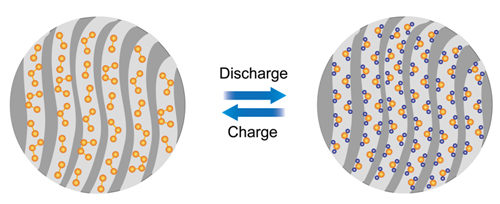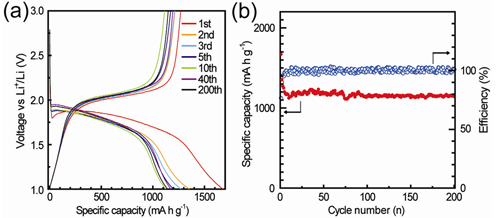With the support of the National Natural Science Foundation of China, the Ministry of Science and Technology, and the Chinese Academy of Sciences, researchers from the Key Laboratory of Molecular Nanostructures and Nanotechnology Institute of the Institute of Chemistry, Chinese Academy of Sciences are solving the problem of dissolution of polysulfide in high-specific lithium-sulfur batteries. An important breakthrough has been made in improving the cycle life of lithium-sulfur batteries. The results of the study were published in the recent J. Am. Chem. Soc. (2012, 134, 18510−18513) and used by the Chemical and Engineering News of the American Chemical Society (ACS) as “High-Energy High-Energy Batteryâ€. Battery Built To Last was commented and reported on.
A lithium-sulfur battery is a type of lithium metal secondary battery in which elemental sulfur (or a sulfur-containing compound) is used as a positive electrode, metallic lithium is a negative electrode, and chemical energy and electric energy are converted to each other through a chemical reaction between sulfur and lithium. Both the elemental sulfur as a positive electrode material and the metal lithium as a negative electrode material have a high theoretical specific capacity, so that the theoretical specific energy of the entire battery is as high as 2,600 Wh/kg, which is more than five times that of the existing lithium ion battery. However, due to the insulative properties of sulfur and its discharge product lithium sulfide (Li2S), and the disadvantage that a series of lithium polysulfide intermediate products formed during charge and discharge are easily dissolved in the electrolyte, the lithium-sulfur battery has poor sulfur cathode activity. The low utilization rate and poor cycle performance seriously affect the performance and practical application of the battery, and it is a difficult problem to be solved.
Scientists from the Key Laboratory of Molecular Nanostructures and Nanotechnology Institute, Institute of Chemistry, Chinese Academy of Sciences, recognized that elemental sulfur exists mainly in the form of cyclic S8, and these easily soluble polysulfides (Li2S8, Li2S6, Li2S4, etc.) are mainly produced in S8 and S42-. The process of transformation between. Together with researchers from the Bosch Asia-Pacific Regional Center for Scientific and Technological Research, they started from the sulfur molecular structure design and proposed the idea of ​​fundamentally solving the problem of the dissolution of this polysulfide ion through the construction of a chain-like small sulfur molecule (S2-4), and passed through the nanopore channel. The spatial confinement effect enables the screening and stabilization of unconventional, metastable small sulfur molecules (Figure 1).
They first synthesized a microporous carbon substrate with a specific pore size (0.5 nm) and then loaded with sulfur. Due to the limitation of the nanopore space, the conversion from S8 molecules to small sulfur molecules can be achieved during the introduction of sulfur, and an unconventional small sulfur molecule/carbon composite cathode material is prepared. They cooperated with scientific researchers of the Institute of Physics of the Chinese Academy of Sciences, and through advanced characterization methods such as spherical aberration correction and transmission electron microscopy, combined with theoretical calculations, proved that the existence of sulfur in such nanochannels is not a normal circular S8 molecule, but a chain-like form. Sulfur molecule S2-4.
It was found that this chain-like small sulfur molecule S2-4 exhibits a distinct electrochemical behavior from the cyclic S8 molecule in the process of insertion/deintercalation, and no soluble polysulfide ions are formed during charge and discharge (Li2S8). , Li2S6, Li2S4), which fundamentally completely solved the traditional sulfur cathode material due to the dissolution of polysulfide ions resulting in poor cycle performance problems. At the same time, since the size of the sulfur particles has been reduced to the molecular level, the electrochemical activity of sulfur is significantly improved. This non-conventional sulfur molecule/carbon composite cathode material based on nanohole confinement effect shows high specific capacity, excellent cycle stability, and high rate performance in lithium-sulfur batteries. The first cycle of the discharge capacity, calculated as sulphur mass, reached 1670 mA h/g, close to the theoretical capacity of the sulphur (1675 mA h/g), and still had 1150 mA h/g after 200 cycles. The discovery of space-limited chain-like small sulfur molecules and their special electrochemical properties is of great significance for the development of high-performance lithium-sulfur batteries for fundamentally solving the problem of sulfur sulfide dissolution from poly-sulfides. The related results have applied for three PCT international patents.

Fig. 1 Schematic diagram of a small sulfur molecule with limited nanochannels / a cathode material for a high-performance lithium-sulfur battery.

Fig. 2 (a) Charge-discharge curve of small sulfur molecule/carbon composite cathode material, (b) Cycle performance at 0.1C rate.
CUT OFF MACHINE
Power Electric Tile Saw,Electric Cut off Machine,Cut off Machine Tools,Hydraulic Cut off Saw
Shanggong Power Tools Factory , http://www.ulite-powertools.com